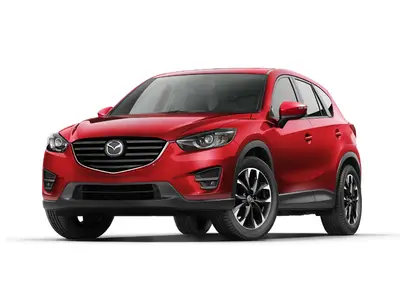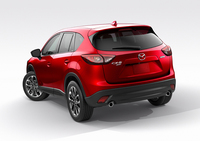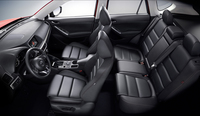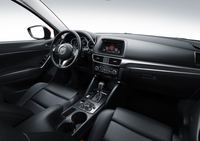2016 Mazda CX-5 Grand Touring FWD Review by Carey Russ
 2016 Mazda CX-5 AWD |
DRIVING DOWN THE ROAD WITH CAREY RUSS
• SEE ALSO: Mazda Research and Buyers Guide
 2016 Mazda CX-5 AWD |
Mazdas are different from other cars. Mazda is a small company and so differentiates its offerings in the marketplace rather than competing directly with the major players. It does that very well, with an emphasis on innovative engineering and cars and even crossovers with a fun-to-drive character. Mazda is the automaker that revived the two-seat convertible roadster with the MX-5 Miata, successfully developed the Wankel rotary-piston engine to power the RX-7 and RX-8 sports cars, and created a crossover that really was a cross between a utility vehicle and sports sedan in the CX-7, its first crossover.
Changes in the auto industry in general and at Mazda in particular brought about realignments in the company's product lineup in recent years. Increasing fuel economy and decreasing emissions have been decreed by governments just about everywhere, and the long-time alliance between Mazda and Ford came to an end. So, in the Mazda crossover lineup, both the performance-oriented CX-7 and Mazda/Ford joint venture Tribute went away after 2012, replaced by the CX-5, an early introduction for the 2013 model year.
The CX-5 debuted the complete SKYACTIV TECHNOLOGY engineering suite, caps Mazda's, and "Sustainable Zoom-Zoom". Skyctiv technology as much an engineering philosophy as it is a collection of hardware and software, with the goal that improved power, torque, and fuel economy don't require compromises in design or safety. Its first implementation was in the driveline of 2012 models of Mazda's core model, the Mazda3. It was further developed in the CX-5 and features in all newer Mazdas. The CX-5 also marked the first use of Mazda’s “KODO-Soul of Motion” design language, seen on and in its newer cars.
The CX-5 was and is much more of a driver’s car than competitive small, affordable crossovers, especially Asian- and American-branded ones. No surprise there, it’s a Mazda. Its original 2.0-liter, 155-horsepower four-cylinder engine sipped fuel — I got an overall 30 mpg in a front-wheel drive example — but was judged lacking in power by too many potential buyers. So for 2014 a 2.5-liter four with 184 horsepower was made available in upper trim levels. Problem solved, and the 2.0 is still offered, with a six-speed manual transmission only, in the entry-level front-wheel drive Sport. A six-speed automatic transmission is the only choice with the 2.5, in automatic Sports and all Touring and Grand Touring models, be they front- or all-wheel drive.
Changes for 2016 are typical for a few years into a car’s production run with exterior and interior styling freshening, adoption of electronic convenience and safety features that were formerly luxury-class equipment, and changes to cabin electronics to take advantage of the latest developments in communication and connectivity. Refinements to the suspension further improve comfort and control, and decrease interior noise levels.
 2016 Mazda CX-5 AWD |
All of which add up to make a good compact crossover even better, as I discovered during my week with a front-wheel drive CX-5 Grand Touring equipped with the electronic systems of the i-Activesense and Tech option packages. Its combination of right size — big enough to comfortably fit four or even five people and reasonable luggage yet small enough to be easily maneuverable and squeeze into tight parking spots — first-class road manners, good power and economy, comfort and interior versatility, and the improved performance from the larger engine make it hard to beat in the compact crossover class. Yes, there are competitors with far more power — but they don’t have the suspension to deal with it as well as the CX-5. Mazda has said “there’s a little MX-5 Miata in all our vehicles” and it’s true.
APPEARANCE: It was the new face of Mazda when it debuted four calendar years ago, and still looks fresh. The proportions are proper for a crossover, taller and more filled-out than a hatchback or even the newer, smaller CX-3. There’s not a completely straight line or flat plane anywhere. The rounded five-point grille shape and size is the same as before but the five horizontal dark metallic gray crossbars are new. The headlight cover shape has changed little, but the lights within are new, and are LEDs with the Tech Package — as are the foglamps and taillights. Both of which are also modestly restyled. It’s cohesive, recognizable, and handsome.
 2016 Mazda CX-5 AWD |
COMFORT: Revised seats, a new console design with an electronic parking brake switch adding a bit of space. The Mazda Connect infotainment system gets a larger touchscreen, at the top center of the dash. It’s also controlled by means of a knob and well-marked hard buttons on the console. Styling, as expected in a Mazda, is more European than Asian or American, with elegant simplicity, high-quality materials, and precise fit and finish. Front seat comfort is very good, with power adjustment on the driver’s side. At Grand Touring level seating surfaces are leather, as is the steering wheel rim. The tilt- and reach-adjustable steering wheel has the usual audio, information, phone, and cruise controls. Backlit instruments are easily read in all lighting. The rear seat cushions are a bit higher than the fronts, for passenger visibility. Headroom won’t be a problem. Legroom and width are good, too, with the usual caveat about the center position being best for small people and short times. A 40/20/40 folding seatback helps usefulness and there is plenty of other space around the cabin. Audio choices are all current varieties.
SAFETY: All CX-5 models get strong safety-oriented unibody construction, front, front-side, and full-length side curtain airbags, and a tire pressure monitoring system. Brakes are four-wheel disc, antilock of course, with electronic brake-force distribution, brake assist and Dynamic Stability Control. Touring and Grand Touring get a blind spot monitoring system that illuminates a spot in the appropriate outside mirror and sounds a chime when a vehicle is in range to the side of the CX-5. The system also alerts for rear cross traffic. Optional are LED headlights that adaptively turn a little in the direction of the steering wheel for improved night vision.
RIDE AND HANDLING: Suspension tuning is where the CX-5 outshines the competition. And that’s been enhanced a bit with new bushings and shock dampers for the fully-independent MacPherson strut front, multilink rear suspension that mean an even better ride quality and no loss of precision response to driver inputs. Further attention to detail in interior materials and soundproofing means a quieter interior as well. The electrically-assisted power steering transmits road feel better than most such. Add it all together and the result is one of the best compact crossovers for people who enjoy driving but need more space than would be found in a hatchback.
PERFORMANCE: The only real deficiency of the first-year CX-5 was under the hood, and even then and there performance wasn’t all that bad. But the chassis could certainly handle more power, and so the 2.5-liter version of Mazda’s Skyactiv inline four found its way into the engine bay. Like the 2.0-liter, it’s of aluminum alloy construction with dual overhead cams, four valves per cylinder, with variable cam phasing for both intake and exhaust for efficiency and power. Direct fuel injection and a high 13:1 compression ratio both further improve efficiency and power, and excellent combustion chamber design allows use of unleaded regular. With 184 horsepower (at 5700 rpm) versus the 2.0’s 155 and especially 185 lb-ft of torque (at a useful 3250 rpm) vs 150, there is a notable improvement in the CX-5’s ability when merging into fast highway traffic. New this year is a Sport mode for the six-speed automatic transmission. As in nearly all cars, the transmission’s regular mode is optimized for fuel economy, and so shifts far below the power peak. And fuel economy is important in this class — and good here, with 27 mpg overall with minimal highway miles. But when there’s a need for speed, or something large coming up quickly from behind, Sport mode is a very good thing. Manual shifting is also available. Yes, there are similarly-sized crossovers with far more power — but they don’t have the refinement or fuel economy of the CX-7.
CONCLUSIONS: Key improvements keep the 2016 Mazda CX-5 at the front of the compact crossover class.
SPECIFICATIONS
2016 Mazda CX-5 Grand Touring
Base Price $ 28,220
Price As Tested $ 32,660
Engine Type DOHC 16-valve inline aluminum alloy 4-cylinder with variable valve timing and direct fuel injection
Engine Size 2.5 liters / 152 cu. in.
Horsepower 184 @ 5700 rpm
Torque (lb-ft) 185 @ 3250 rpm
Transmission 6-speed automatic
Wheelbase / Length 106.3 in. / 178.7 in.
Curb Weight 3433 lbs.
Pounds Per Horsepower 18.7
Fuel Capacity 14.8 gal.
Fuel Requirement 87 octane unleaded regular gasoline
Tires P225/55R19 99V m+s Toyo A23
Brakes, front/rear vented disc / solid disc, ABS
Suspension, front/rear independent MacPherson strut / independent multilink
Drivetrain transverse front engine, front-wheel drive
PERFORMANCE
EPA Fuel Economy - miles per gallon city / highway / observed 26 / 33 / 27
0 to 60 mph 7.6 sec
OPTIONS AND CHARGES
Cargo Tray $ 75
Rear Bumper Guard $ 100
Retractable Cargo Cover $ 200
Door Sill Trim Plates $ 125
Wheel Locks $ 55
GT i-Activesense Package — includes:
Mazda Radar Cruise
Control, Smart Brake Support, Lane Departure Warning, High Beam Control $
1,500
Grand Touring Tech Package — includes:
Navigation System,
Adaptive Front Lighting, LED headlights, front running lights, foglamps,
combination taillights, Smart City Braking Support, Auto-Dim Mirror with
Homelink $ 1505
Destination Charge $ 880


